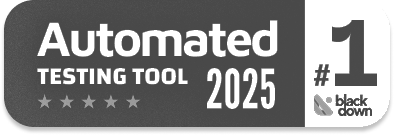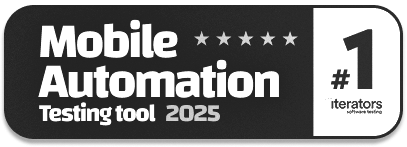Shift Everywhere in Software Testing: The Future with AI and DevOps
|
|
The last several decades have seen software testing experience an incredible transformation, as it has ceased to be a post-development validation process and has become a continuous and strategic process that is integrated throughout the software lifecycle. The shift-left and shift-right paradigms brought the concept that quality is not an afterthought but a part of all development and operations.
However, as software systems become more complex, more distributed, and more dynamic due to artificial intelligence (AI), cloud-native architectures, and DevOps practices, testing requires an even wider perspective.
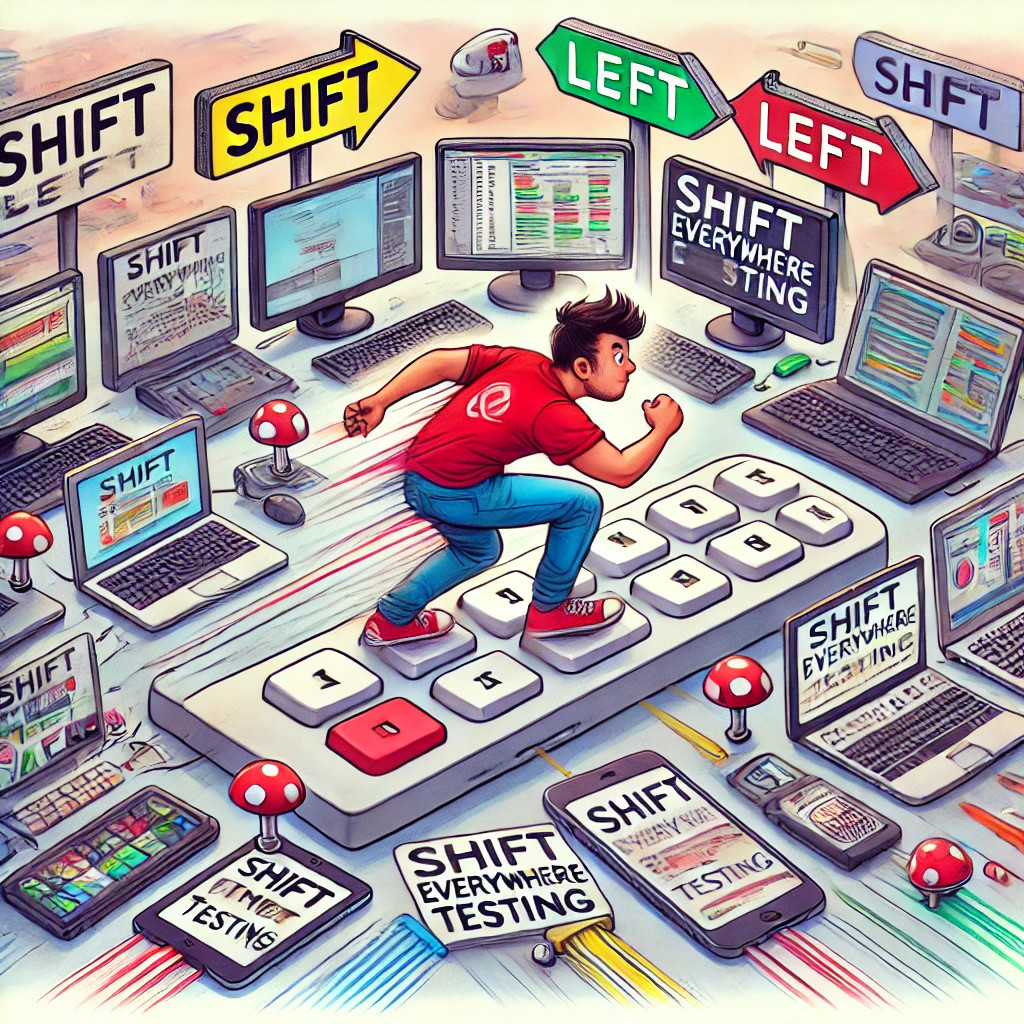
Here, the idea of ‘Shift Everywhere‘ is born: a comprehensive model that goes beyond the dichotomy of early or late testing. Rather, quality becomes a ubiquitous task that is distributed among teams, processes, and technologies. DevOps supports this change by making testing a part of continuous integration, delivery, and monitoring, and AI supports it with automation, intelligence, and flexibility. The intersection of DevOps and AI is transforming the role of testing as a specialized activity into a cultural and organizational attitude.
The movement toward ‘Shift Everywhere’ is not only a technical revolution, but also a change in the way organizations understand quality: as a collective, ongoing, and smart process that transcends time, position, and process boundaries.
| Key Takeaways: |
|---|
|
The Origins: Shift-Left
The idea of shift-left testing was developed due to the necessity of dealing with defects at an earlier stage of the software lifecycle. Conventional testing was usually done at the end of the development process, which was very expensive and time-consuming when problems were found at the last stage. Organizations could identify and fix issues earlier by shifting testing activities to the left of the timeline, i.e., to requirements analysis, design, and development. Read more: Shift Left Testing – Software Testing Done Early.
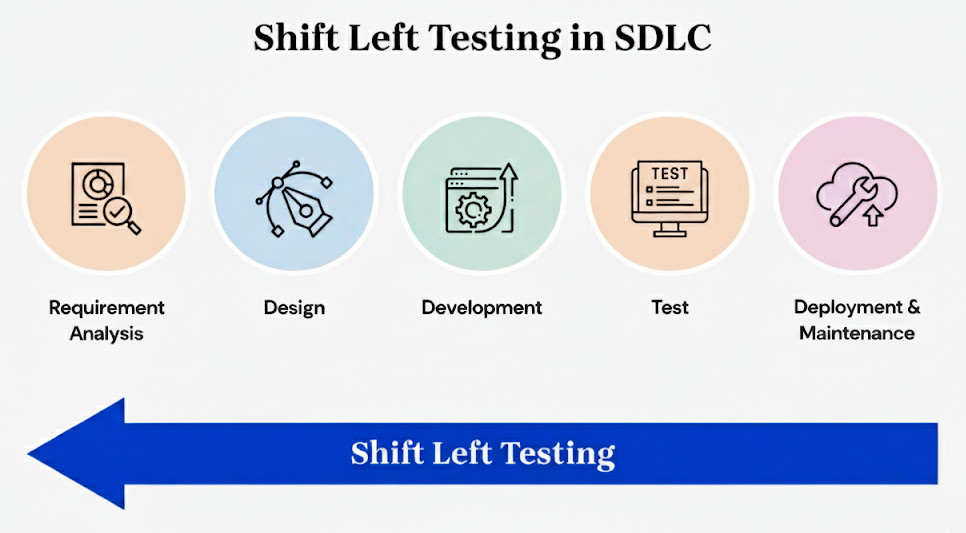
Practices like unit testing, static code analysis, and test-driven development (TDD) embody this philosophy. The value proposition was straightforward: the sooner the testing, the sooner the feedback, the less rework, and the better quality. Read: What is Test Driven Development? TDD vs. BDD vs. SDD.
The Counterpart: Shift-Right
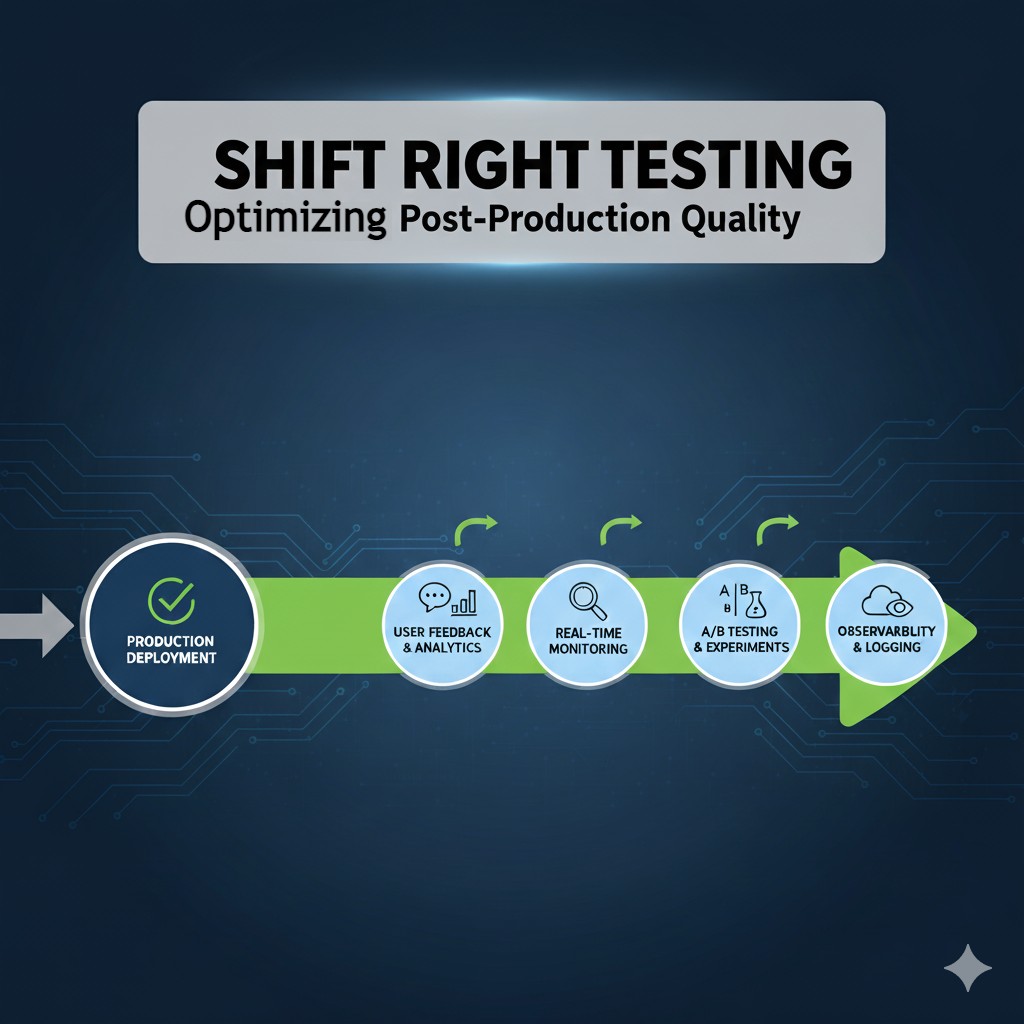
Whereas shift-left is concerned with prevention, shift-right testing is concerned with validation in production-like settings. As modern applications are constantly deployed and consumed by millions of users, real-world conditions cannot always be simulated in pre-production environments. Shift-right proposed techniques, such as canary releases, A/B testing, chaos engineering, and production monitoring, to test software behavior in live conditions. This method is centered on resilience, user experience, and constant feedback of production systems, which guarantee quality even after pre-release stages.
Read more: Shift-Right Testing: What, How, Types, and Tools.
Beyond the Dichotomy: Shift Everywhere
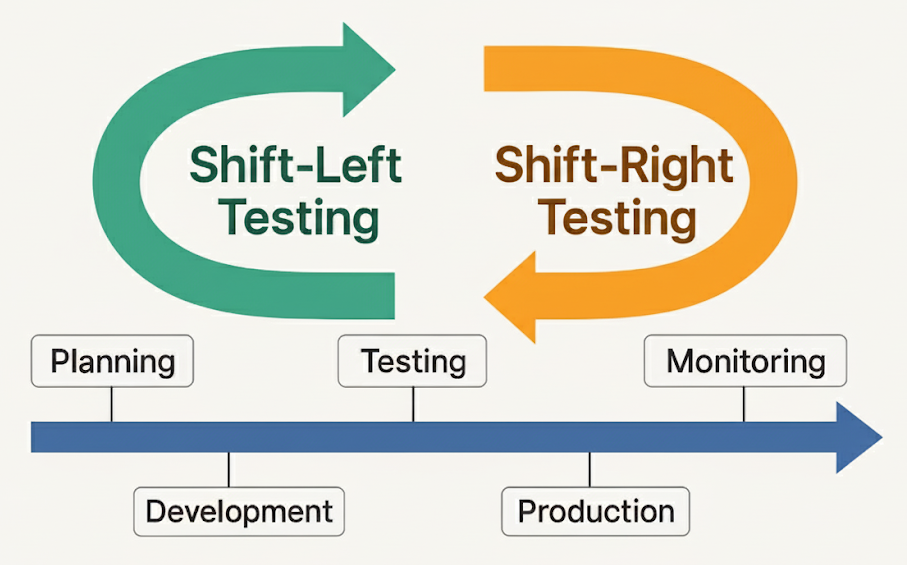
Both shift-left and shift-right have their own benefits, but they are not mutually exclusive. ‘Shift Everywhere’ understands that testing should not be limited to the early or late phases of the lifecycle. It combines the two philosophies into an ongoing, ubiquitous practice. In this model, quality is not limited to a stage but is integrated throughout ideation to production and beyond. Teams develop a culture of believing that quality checks are automated and intelligent at all touchpoints, be it in design discussions, code reviews, deployments, or operational monitoring.
Why Neither Approach Alone is Enough
Neither shift-left nor shift-right can alone meet the needs of the modern complex, AI-driven, cloud-native ecosystems. Shift-left can identify design flaws early, but it cannot test scalability or real-world usage patterns. On the other hand, shift-right is good at resilience testing but does not do much to avoid problems during the design phase. Companies that use only one strategy are prone to blind spots that may cause expensive failures. The fact is that the current software needs prevention and validation, which are continuous and interconnected.
Defining “Shift Everywhere” as a Holistic Model
The best way to think of ‘Shift Everywhere’ is as a holistic quality paradigm that integrates prevention, validation, and continuous improvement. It does not see testing as a separate activity but as a continuous practice that is part of each stage, process, and role. This involves early design validation, automated unit and integration testing, deployment validations, observability-based monitoring, and AI-assisted defect prediction. Through lifecycle quality practices, organizations can make sure that testing keeps up with the system instead of falling behind it.
Testing as a Cultural and Organizational Mindset
Fundamentally, ‘Shift Everywhere’ is not about tools but culture. Quality is a collective responsibility and not the task of a special QA team. Testing and quality assurance are done by developers, testers, operations staff, and business stakeholders, with a quality-first attitude. The organization is open to continuous learning, quick feedback, and active collaboration, in which testing is more about avoiding defects than it is about value delivery. This cultural transformation reinvents QA as a gatekeeping role into a speed, resilience, and innovation enabler.
The Role of DevOps in Shifting Everywhere
DevOps is the backbone of the shift everywhere approach, embedding testing and quality into every stage of the software lifecycle. Uniting development, operations, and testing with automation and continuous feedback ensures faster, more reliable, and value-driven delivery.
Continuous Integration and Continuous Delivery (CI/CD)
The core of DevOps is the concept of flow that is driven by automation, which is facilitated by CI/CD pipelines. Continuous Integration makes sure that code changes are regularly merged, automatically built, and tested, and defects are detected early and often. Continuous Delivery builds on this by automating the deployment process so that each build is ready to be deployed. CI/CD pipelines are the foundation of continuous quality in a Shift Everywhere model. Unit, integration, performance, and security tests are automated and run smoothly at each phase, and AI-enhanced tools can dynamically adjust test coverage. This forms a fast feedback loop in which testing is not a stage but a component of software flow, ensuring quicker releases without compromising quality. Read: What is CI/CD?
Breaking Silos
Traditional testing was often isolated within the QA team, and it created a bottleneck and piecemeal responsibility. DevOps eliminates these silos by encouraging co-operation among development, operations, and quality groups. ‘Shift Everywhere’ thrives in this kind of environment, as developers/testers write automated tests, operations teams add to monitoring strategies. Testers become quality engineers who help to bridge the technical and business viewpoints. The shared ownership of quality would remove the handover culture and establish a culture of accountability to deliver dependable, durable, and user-friendly software.
Observability and Monitoring as Testing
Observability and monitoring are not just operational concerns in a DevOps-driven ecosystem; they are testing extensions. ‘Shift Everywhere’ believes in the concept that real-world usage, system telemetry, and user interactions are invaluable sources of feedback regarding the quality of software. Live quality checks are measurements such as latency, error rates, throughput, and user experience insights. The practices of synthetic monitoring, chaos testing, and anomaly detection blur the line between testing and operations, enabling teams to actively identify and resolve issues before they impact users. By doing so, observability is a continuous validation mechanism that helps to support the holistic vision of quality throughout the lifecycle.
The AI Revolution in Testing
The AI revolution in testing is transforming how teams ensure quality by introducing intelligence, automation, and adaptability at every stage of the lifecycle. From self-healing tests to predictive analytics, AI empowers organizations to achieve faster, smarter, and more resilient software delivery.
Why AI is Critical for Shift Everywhere
With the increasing complexity of software ecosystems, microservices, cloud-native deployments, continuous releases, traditional testing approaches are no longer able to keep up. AI offers the intelligence, flexibility, and speed needed to make ‘Shift Everywhere’ a reality. Learning patterns, analyzing large amounts of data, and automating repetitive tasks, AI transforms testing into a self-optimizing, ongoing process.
It allows teams to balance the speed of DevOps without sacrificing quality, sealing the gaps that cannot be closed by human-driven processes alone.
Self-healing Automation in Dynamic Systems
Containers spin up and down, APIs change, configurations change, and modern systems are dynamic and AI-driven. This volatility tends to destroy conventional automated tests. This is solved by AI-based self-healing automation, which modifies test scripts on the fly. Tools like testRigor, powered by AI, are more valuable than traditional tools. Unlike conventional tools that use web elements’ properties as locators, testRigor, with its AI algorithms, identifies elements based on their screen name or locations, thereby reducing flakiness. With its AI-based self-healing capability, the maintenance is very low, and tests are more stable and reliable. Read how you can decrease test maintenance time by 99.5% with testRigor.
AI-driven Test Case Generation from Requirements and Data
Developing detailed test cases is one of the most resource-consuming activities in QA. AI can potentially convert requirements, user stories, and production data into automatically generated test cases. Natural language processing (NLP) enables AI to process requirements and build meaningful scenarios, and machine learning can process user behavior data to identify high-risk workflows.
testRigor uses Vision AI, NLP, AI context, and other advanced algorithms to create automation test scripts, thereby empowering manual testers and other non-technical stakeholders to create or update them. This makes everyone capable of automating tests.
Intelligent Test Execution and Risk-based Prioritization
It is not possible and efficient to test everything. AI can improve execution by using risk-based prioritization, i.e, which tests to execute first, depending on code changes, historical defect patterns, and usage analytics. To illustrate, AI can prioritize relevant tests when a feature with high user traffic has been modified. This maximizes resource utilization, accelerates feedback loops, and ensures that the most critical risks are proven out as quickly as possible. Read: Risk-based Testing: A Strategic Approach to QA.
AI in Defect Prediction and Root Cause Analysis
AI is not only able to detect defects, but it can also anticipate or predict them. AI models can forecast the most likely defect locations using historical data, commit histories, and system metrics. This allows teams to proactively test high-risk areas and to efficiently allocate resources. In addition, AI speeds up the root cause analysis process by matching logs, metrics, and historical fixes to identify the source of failures. This minimizes the mean time to resolve (MTTR) and improves the testing-development feedback. Read more: Root Cause Analysis Explained.
The Rise of Generative AI for Testing
Generative AI is transforming the way tests are developed and performed. Large language models (LLMs) are capable of producing test scripts, API calls, and exploratory scenarios based on plain-text requirements or production logs. They also support conversational test design, in which testers write scenarios in natural language, and AI converts them into executable tests. Generative AI may even be used to simulate various user personas, environments, or edge cases that human testers may miss. This democratizes the creation of tests and speeds up coverage across domains.
The Road Toward Autonomous, AI-first Testing
The final path of AI in testing is too autonomous, AI-first pipelines where machines actively design, run, heal, and optimize tests with little human intervention. Human testers become quality strategists and AI supervisors, leading models, validating results, and prioritizing ethics, usability, and business value. In the long run, testing is a self-sustaining ecosystem in which AI learns continuously based on production data, dynamically adjusts coverage, and maintains quality at machine speed, with a human in the loop.
How Shift Everywhere Transforms QA Roles
- From test executors to quality strategists: In the old paradigm, QA professionals were commonly test executors, running manual or scripted tests that were given to them by development teams. Their role in a ‘Shift Everywhere’ paradigm is changed to that of quality strategists. Rather than emphasizing the checking functionality, QA now has an impact on the quality embedded throughout the lifecycle. They develop automation, risk-based testing, and AI-based validation strategies so that testing is aligned with technical and business goals.
- Expanding QA skill sets: coding, DevOps, AI literacy: The new environment requires a wider and more comprehensive skill base of QA professionals. Knowledge of coding is needed to develop automation systems, to incorporate tests into CI/CD pipelines, and to collaborate with developers. DevOps literacy allows QA to gain knowledge of infrastructure, observability, and deployment processes. Moreover, AI literacy, or the ability to operate, manipulate, and adjust AI-based testing tools, becomes one of the key differentiating factors.
- Collaboration with development and operations teams: ‘Shift Everywhere’ eliminates silos, and QA professionals are at the core of the change. They need to work hand in hand with developers to make code testable early, and with operations teams to make monitoring, chaos testing, and observability part of the quality process. This inter-functional teamwork creates a sense of collective responsibility whereby QA acts as an interface between technical implementation and user demands.
-
Human-AI collaboration in testing: As AI becomes more involved in the generation of test cases, their execution, and prediction of defects, the role of QA is changing to human-AI cooperation. Testers observe the outputs of AI and ensure that they are relevant, as well as provide the contextual judgment that machines cannot reproduce. To illustrate, AI is able to generate hundreds of test scenarios, yet it is up to humans to decide which ones are most pertinent to business risks.
- The rise of quality engineering as a discipline: The result of this change is the development of quality engineering as a discipline. Unlike traditional QA, quality engineering is proactive, automation-oriented, and DevOps and AI-oriented. Quality engineers build resilient test architectures, promote observability, combine AI-based tools, and promote the cultural adoption of continuous quality. Read: What is QE or Quality Engineering Score?
The Future of Testing: A World of Intelligent Automation
Let us review how the shift everywhere will transform the future of testing:
Autonomous Pipelines for Continuous Quality
The logical extension of DevOps and AI-based testing is autonomous pipelines in which quality is constantly checked without human intervention. In this vision, CI/CD becomes CI/CD/CQ (Continuous Quality) pipelines, with AI automatically picking, running, healing, and optimizing tests. Feedback loops run between commits to code and live user experiences, forming a system in which software is self-tested at each stage. Human supervision is still necessary, but most of the repetitive work is transferred to intelligent automation, and teams can concentrate on innovation instead of maintenance.
DevOps and AI Convergence: AIOps in Testing
DevOps and AI come together to create AIOps in testing, where predictive analytics, anomaly detection, and adaptive automation are integrated into operations. AIOps allows testing systems that not only respond to failures, but also predict threats before they happen. One such example is that predictive models can alert about possible performance degradation before it impacts users, or identify security vulnerabilities as code is deployed. This is an active, data-driven model that aligns testing with operational intelligence and is reliable at machine speed. Read: What is AIOps?
Software Ecosystems as Self-validating Organisms
With the rise of applications as complex, interconnected ecosystems, testing moves beyond component validation to systemic health. Software ecosystems will operate as self-validating organisms in the future, able to check their own performance, identify anomalies, and take corrective measures. Observability, AI, and automation come together to form systems that respond to changing conditions and constantly prove their integrity.
This is a paradigm shift: self-testing software.
Ethical and Human Dimensions of AI in Testing
The ethical dilemma arises with the advent of AI-based testing. Bias in AI-generated tests, over-automation, or lack of transparency in defect predictions can destroy trust. Human testers will play a significant role in controlling AI, and it will be fair, explainable, and accountable. In addition, ethical implications also apply to user privacy, particularly as testing becomes more dependent on production data. Ethics will become a core aspect of quality as the future of testing will balance automation and human judgment, empathy, and responsibility. Read: What is Explainable AI (XAI)?
Long-term Vision: Quality Everywhere, All the Time
The long-term path is one in which quality is everywhere, not a stage, tool, or team, but a part of the software delivery DNA. Testing is made invisible but omnipresent: all commits are verified, all releases are tracked, all anomalies are forecasted, and all decisions are made with data.
AI, DevOps, and cultural changes come together to form an environment where quality is not a result, but a state of being. Software in this world is resilient, trusting, and agile, allowing organizations to innovate confidently in the face of change.
Wrapping Up
The journey from Shift-left and Shift-right to ‘Shift Everywhere’ represents a true evolution in how organizations approach software quality. Quality becomes a shared responsibility rather than a final checkpoint by embedding testing across every stage of the lifecycle and leveraging DevOps for automation and collaboration.
AI-powered tools such as testRigor bring this vision closer to reality by enabling self-healing automation, reducing test maintenance, and empowering both technical and non-technical teams to contribute to quality. Ultimately, ‘Shift Everywhere’ ensures that software is not only functional but also resilient, reliable, and capable of supporting innovation at scale.
| Achieve More Than 90% Test Automation | |
| Step by Step Walkthroughs and Help | |
| 14 Day Free Trial, Cancel Anytime |



